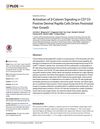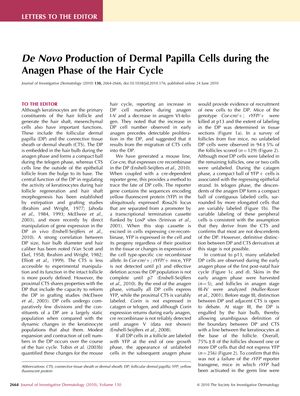TLDR New cells are added to the hair's dermal papilla during the active growth phase.
The study investigated the generation of new dermal papilla (DP) cells in mice during the anagen phase of hair growth. Researchers created a mouse line, Cor-cre, to track DP cells using a fluorescent protein marker. They discovered that by the end of the anagen phase, almost all DP cells were labeled with yellow fluorescent protein (YFP), indicating the addition of new cells to the DP. This finding was supported by the absence of unlabeled DP cells in sectioned follicles. The results suggest that the anagen phase environment promotes the recruitment of new cells to the DP, which is relevant for understanding hair growth and loss. The study, which analyzed 129 follicles at post-natal day 13 and 256 follicles during early anagen from five mice, highlights that DP size regulation is dynamic and suggests that maintaining hair size is not due to a static DP cell population. Identifying the source of DP progenitor cells and the mechanisms controlling DP cell quantity could aid in developing better hair loss treatments.
 314 citations
,
April 2010 in “Developmental Cell”
314 citations
,
April 2010 in “Developmental Cell” β-catenin in the dermal papilla is crucial for normal hair growth and repair.
 330 citations
,
December 2009 in “Cell stem cell”
330 citations
,
December 2009 in “Cell stem cell” SKPs are similar to adult skin stem cells and could help in skin repair and hair growth.
 208 citations
,
December 2003 in “Journal of Investigative Dermatology”
208 citations
,
December 2003 in “Journal of Investigative Dermatology” Certain cells from hair follicles can create new hair and contribute to hair growth when implanted in mice.
 54 citations
,
June 2003 in “The journal of investigative dermatology. Symposium proceedings/The Journal of investigative dermatology symposium proceedings”
54 citations
,
June 2003 in “The journal of investigative dermatology. Symposium proceedings/The Journal of investigative dermatology symposium proceedings” Disruptions in hair follicle fibroblast dynamics can cause hair growth problems.
158 citations
,
May 2003 in “Journal of Investigative Dermatology” Hair growth is influenced by dynamic changes in hair follicle cells, which could help treat hair loss.
231 citations
,
December 1999 in “Journal of Investigative Dermatology” Hair follicle size is mainly influenced by the number of cells and extracellular matrix volume, with cell number having a larger impact.
30 citations
,
February 1977 in “Nature” The dermal papilla can still grow new hair even after heavy radiation.
 26 citations
,
July 2016 in “PLOS ONE”
26 citations
,
July 2016 in “PLOS ONE” Activating β-catenin in certain skin cells speeds up hair growth in mice.
 April 2016 in “Journal of Investigative Dermatology”
April 2016 in “Journal of Investigative Dermatology” Wnt ligands, produced by dermal papilla cells, are essential for adult hair growth and regeneration.
95 citations
,
July 2006 in “British Journal of Dermatology” Vitamin D receptors in hair follicles change with the hair cycle, affecting hair growth.







